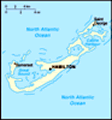Advertisement
Published: January 16th 2023
After a long sleep, I enjoyed the breakfast things left for us in the room. The caterer doesn’t work on Sundays, and the hotel restaurant was closed. At 11:00 we met as a tour group near the pool, a few steps from my room. Tim Rogers is our guide’s name. He and his wife are the only full-time guides on the island. She is Bermudian; he was born in England and came to Bermuda to work when Thatcher’s cutbacks hit universities. He was originally a botanist but is now one of those people who are well-informed in many fields. Every question was answered thoroughly, simply and with good humour. Our group consists of a former school teacher named Bev (met on the plane), a well-retired woman on her first walking tour “alone” named Ruth, and an auditor from Washington, DC named Arlene.
Our start was across the road from the hotel, up a steep road called Tribe Road No. 1. There are many of these, and the numbering starts anew for each parish. Originally, the island was divided across the narrow width and allotted to all the bigwigs. They enslaved African and North American Indians, mainly as a

 Tribe Road No.1
Tribe Road No.1
Note all the whitewashed roofs that collect water directed to the basement cisterns.show of power, because there weren't many fields to cultivate. The Indians were allowed to wander about, but they were thrashed for trespassing. Eventually, the governor conceded and allowed for Tribe roads between every other private property – an irregular distance as property sizes varied. Now these roads are used for regular traffic – No. 1 was paved, but No. 7 later in the day was dirt.
The steepness is because in the northern and southern ends of the island there is a spine, about as steep as the escarpment in Calgary.
On the other side of the spine, we turned and walked along the Railway Trails. Naturally, these are where there was a railway (tracks lifted); the railway was not a success and lasted only from post WWII into the fifties. Now there are lots of trees and vines and ferns. Tim showed us many of these, pointing out the many foreign plants that were brought by various Victorian governors and travellers. One of the native trees is allspice. Tim broke off a leaf and had us guess by the smell. Heavens! I was the first to guess right. I actually said, “Cinnamon, or something like allspice.”
I didn’t really think “allspice” was a separate spice. It is a relative of clove, and its oily leaves give “oil of clove” that is genetically the same as that given by clove.
We ate a picnic lunch sitting on a stone wall. Most construction is of stone quarried out of the limestone just below the thin soil; limestone purifies the water naturally. The houses are plastered with lime grout and then painted. The roofs are all painted with lime wash, by law, every four years, because all the island’s potable water comes from rain stored in the basement cisterns. We saw the cistern for an unfinished house. It is in two basins separated by a half-height wall. When the weather is dry enough, the water sinks and divides into two pools. The pump drains one and then that part of the cistern is cleaned. Then the other is drained and cleaned.
We crossed back over Tribe Road No. 7 to see a series of beautiful sandy beaches – pale pink powdery sand and beautiful turquoise water. Since there are no rivers or streams, there is virtually no turbidity. All afternoon we strolled from beach, over small heights
of land, to another beach. Tim told us about more plants and how they each protect themselves from salt – usually hairy leaves (hold the salt off until dew washes them) or waxy leaves.
Dinner was at a brewery and pub. I had spinach salad and baby-back ribs, as recommended by Tim, with a glass of locally brewed porter. Only the carrots (in season) were local, as virtually all food is imported. The little land there is has been swallowed by businesses and homes.
A digression on the economy, delivered while toiling up Tribe Road No. 1: The homes we saw (nice but not spectacular) cost about US$1 million. The average salary is $84,000; a truck driver or hotel worker makes $40,000. Average rents are $7000 per month for a small apartment and $9000 per month for a small house. A quart of milk is $7.00, and a gallon of gas is $6.75. There is one dairy of about 200 cows, and it has a government-enforced monopoly. When local produce is in season, like the carrots, imported produce is embargoed to ensure the sale of the local product. Education is not widely respected because it is widely available,

 Water cistern
Water cistern
Mandatory use of basement to store rain waterincluding post-secondary. The economy is managed to a level of no unemployment.
View Google map of Bermuda.
Advertisement
Tot: 0.07s; Tpl: 0.012s; cc: 7; qc: 23; dbt: 0.039s; 1; m:domysql w:travelblog (10.17.0.13); sld: 1;
; mem: 1.1mb














Isabel Gibson
non-member comment
Fascinating - and a perfect example of why business travel is (or can be) so limited. I had no idea that Bermuda had no rivers, or that their economy was so managed. Looking forward to more surprises! (Your beach and rock photos show a striking landscape very well.)